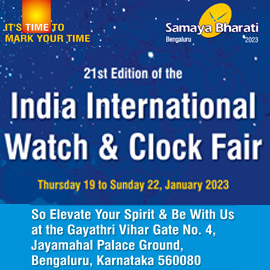EDITALK
Time to Unite! With Unified Commerce Concept
For several years now, business houses in India used to sell their products either through Family owned Pop & Mom stores or through their Company- owned outlets. However, in the more recent times, there has been a noticeable shift, in that they also began to sell through kiosks at Shopping Malls, and Large Format Stores and in the most recent years, even through online market places. But, it's observed that, our country is now experiencing a spurt of digital activity in the retail space. If we go by a Deloitte India report released recently, it has guestimated that India's online retail market will touch $325 billion by 2030, which is indeed a huge jump from the estimated $70 billion back in 2022. The principal driver leading to this expected growth, is apparently the shift from Tier 1(large cities) to Tier ll and lll (smaller cities) markets, where consumers are rapidly and at a much faster pace adopting digital shopping. This is perhaps caused by our shopping habits that have undergone a fundamental change in recent years, Whether we scroll through our mobile phones late at night or walk into a store on a Sunday afternoon, we expect a fast, convenient and consistent shopping experience. This is where Unified Commerce has come in and is quickly becoming the order of the day as also, an essential part and parcel of retail in India perhaps by the end of 2025. Another significant trend observed is the rise in omnichannel sales. The country's retail sector is expected to grow fivefold in the next three years and reach approximately $55 billion, up from $11 billion. If we examine the numbers, it emanates as clear as crystal, that shopping habits have evolved rapidly in India, and Unified Commerce, is at the forefront of this transformation happening at an incredible speed over here. But what is Unified Commerce? Omnichannel retail involves selling across multiple platforms—online stores, apps, and brick-and-mortar stores. However, these channels often operate independently of each other. For instance, one might see one price online and a different one in-store, or one's loyalty points might not sync across channels. Unified Commerce takes this concept a step further by integrating all shopping channels into a single platform. This implies consolidating inventory, payment processing, customer data, and loyalty rewards—everything is connected in real-time. Whether one shops online, pays via an app, picks up from a store, or returns an item through a courier, one's experience is always seamless and continuous. One can hence think of Unified Commerce as the backend magic that tailors one's shopping journey and makes it enjoyable. And, why does Unified Commerce Matter? Unified Commerce is crucially important in the present day, because it simplifies the shopping experience while empowering retailers to operate more efficiently. For retailers, it solves the problem of creating a truly seamless experience. Imagine checking the availability of a product, reserving it, and then picking it up from a store—all without ever needing to make a phone call. Everything works smoothly, and the process is entirely seamless. It also helps businesses manage inventory more effectively behind the scenes. With real-time visibility of stock across all locations, we’ll see fewer instances of having to hear, "Sorry, this item is out of stock." It’s a win-win situation for both retailers and customers. Loyalty programs also benefit, as customers can earn and redeem rewards seamlessly across online, offline, and mobile channels. While most big retail stores have already adopted the Unified Commerce model and also practising it, it is the smaller retailers or family- owned retail stores who as a matter of fact, and of course with the active support of companies whose products they retail, need to adopt it, before it gets too late. If anything, they will only gain from this model. For instance, if we take the horological field, some companies who are foresighted and think out-of-the-box, have worked arduously to encourage their MBRs in Tier ll and lll cities to change their outlook and modus operandi, and laid before them a new option. An example in this forward thinking, is but of course Titan Company. About two years ago, they introduced the Light House and Parivartan (Change) concepts to their MBRs, which though, are not exactly the Unified Commerce model as it were, but both are also moving in the same direction. As a Company which always moves with the times, and is forever at the forefront of churning new ways and ideas to help its business partners go forward and prosper, Titan Company has always set an example. As an entity of national and global renown, it has never left any stone unturned in working to discover and create new ideas and concepts that help each and everyone associated with it, on moving up the growth path. The objective of Titan has always been to not just think about its own stores, but also about the MBRs that retail Titan, its other sister and licensed brands or in some cases, even other brands. In a rapidly changing and forever evolving market scenario, it is hence very important for a manufacturing company to encourage its partners in this journey towards progress as well as help them grow along with the Company. With a view thus to address the somewhat eroding pattern of growth of its Multi-Brand Retailers, Titan Company therefore initiated its 'Light House' and 'Parivartan' journeys. The planned transformation, focused itself at 5 key elements, these being: Look and Feel, Digitization, Merchandizing Solutions (TOC), Customer Relationship Management (CRM) and Training and Development of people. The advantages that accrued as a direct result of this journey of transformation included: Demand Creation, Demand Capture and Demand Retention. By elevating the in-store and out-store experience that customers confronted, these retailers attracted and retained customers, increased their sales and also firmly established the brands they sold. And following Titan, other watchmaking companies too have initiated similar programmes. Unified Commerce is especially critical in India, where shopping behaviours vary as widely as the languages spoken across the country. Perhaps, by 2025 end, Indian shoppers will demand speed, simplicity, and personalization. This is likely why the quick commerce segment has grown rapidly. The Unified Commerce Concept thus makes this possible by integrating inventory, logistics, and customer data, ensuring a smooth and seamless process from the moment an order is placed to when it reaches one's doorstep. The Benefits of Unified Commerce and what it means for Retailers -Today, retailers need more than just a website or mobile app. They require systems and platforms that communicate with each other. This isn't just about boosting sales; it’s about building stronger relationships with customers. When shoppers feel that their concerns are addressed and valued, they are more likely to return. That's why, in 2025, these relationships will be more valuable than ever. And what be the challenges? Integrating and managing unified systems comes with costs. Smaller retailers, in particular, may struggle with the financial investment required. Additionally, training staff to work with these systems is key to ensuring successful implementation. Looking ahead, Unified Commerce will likely be soon seen as essential, rather than optional. With India’s millions of mobile-first shoppers and increasingly high expectations, only brands that understand, adopt, and execute Unified Commerce will thrive. Unified Commerce will help brands become smarter, more efficient, and more human in their approach. As for the Road Ahead, Unified Commerce is not just a technological upgrade; it’s a shift in mindset. It’s about creating frictionless, personalized, and connected shopping experiences. India’s tech-savvy shoppers won’t now tolerate separate shopping experiences—they’ll want everything integrated into one seamless platform. Unified Commerce will help retailers deliver that. And so, as we have all just entered FY2025-2026, and the way things are moving in India with the Indian shopper in 2025 having not only become Digital Savvy, but also Demanding and Diverse at the same time, it's high time that even the smaller family-owned retailers , seriously plan to work towards adopting the Unified Commerce model along with brand initiatives, and get going smartly into a hopefully rewarding future!





